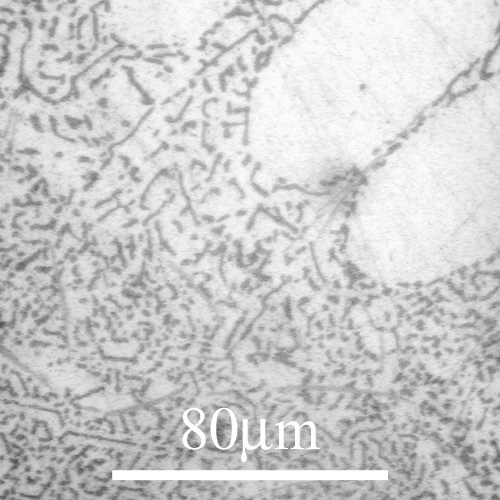Micrograph Library
Browse the libraryAdvanced searchSystemsCompositionsTechniquesKeywordsPhase diagramsHelpPreferencesAbout the micrograph libraryTerms of useContribute micrographs!FeedbackLinksCredits Print this page

Micrograph 59 and full record

- Micrograph no
- 59
- Brief description
- Al 88, Si 12 (wt%), eutectic alloy
- Keywords
- alloy
 , aluminium
, aluminium  , eutectic
, eutectic  , metal, modification
, metal, modification  , silicon
, silicon 
- Categories
- Metal or alloy
- System
- Al-Si

- Composition
- Al 88, Si 12 (wt%)
- Standard codes
- Reaction
- Processing
- As-cast (metal mould)
- Applications
- Sample preparation
- Technique
- Reflected light microscopy
- Length bar
- 80 μm
- Further information
- This sample is a casting alloy of eutectic composition. From the melt a eutectic is formed between aluminium solid solution and virtually pure silicon. Slow solidification produces a very coarse microstructure. The eutectic comprises large plates of silicon in the aluminium matrix. This microstructure displays poor ductility due to the brittleness of large silicon plates. The microstructure is normally refined through either rapid solidification, which lets the silicon phase assume a fibrous form, or by a process known as modification.
It may be noted that primary aluminium dendrites can be seen, although the composition is very close to the eutectic point and an entirely eutectic microstructure might thus have been expected. This effect is a consequence of the strongly skewed nature of the eutectic "coupled zone" in the Al-Si system. The coupled zone represents the combinations of melt composition and interfacial undercooling (or growth velocity) for which (coupled) eutectic growth can occur. It can be plotted on the phase diagram by extending the two liquidus lines below the eutectic temperature. The Si liquidus line curves sharply back towards higher Si contents as the undercooling is increased. (This is associated with the facetted growth mode of the Si phase.) Thus, depending on growth conditions, a nominally eutectic alloy may solidify initially outside the coupled zone, leading to primary aluminium dendrite formation (before the melt composition rises sufficiently for the coupled zone to be entered and eutectic growth to occur). For more details, see, for example, Acta Mater. vol. 40 (1992) p.1637-1644. - Contributor
- Prof T W Clyne
- Organisation
- Department of Materials Science and Metallurgy, University of Cambridge
- Date
- 25/10/01
- Licence for re-use
 Attribution-NonCommercial-ShareAlike 4.0 International
Attribution-NonCommercial-ShareAlike 4.0 International- Related micrographs
View image alone .. in a new window
Help is available on downloading images

